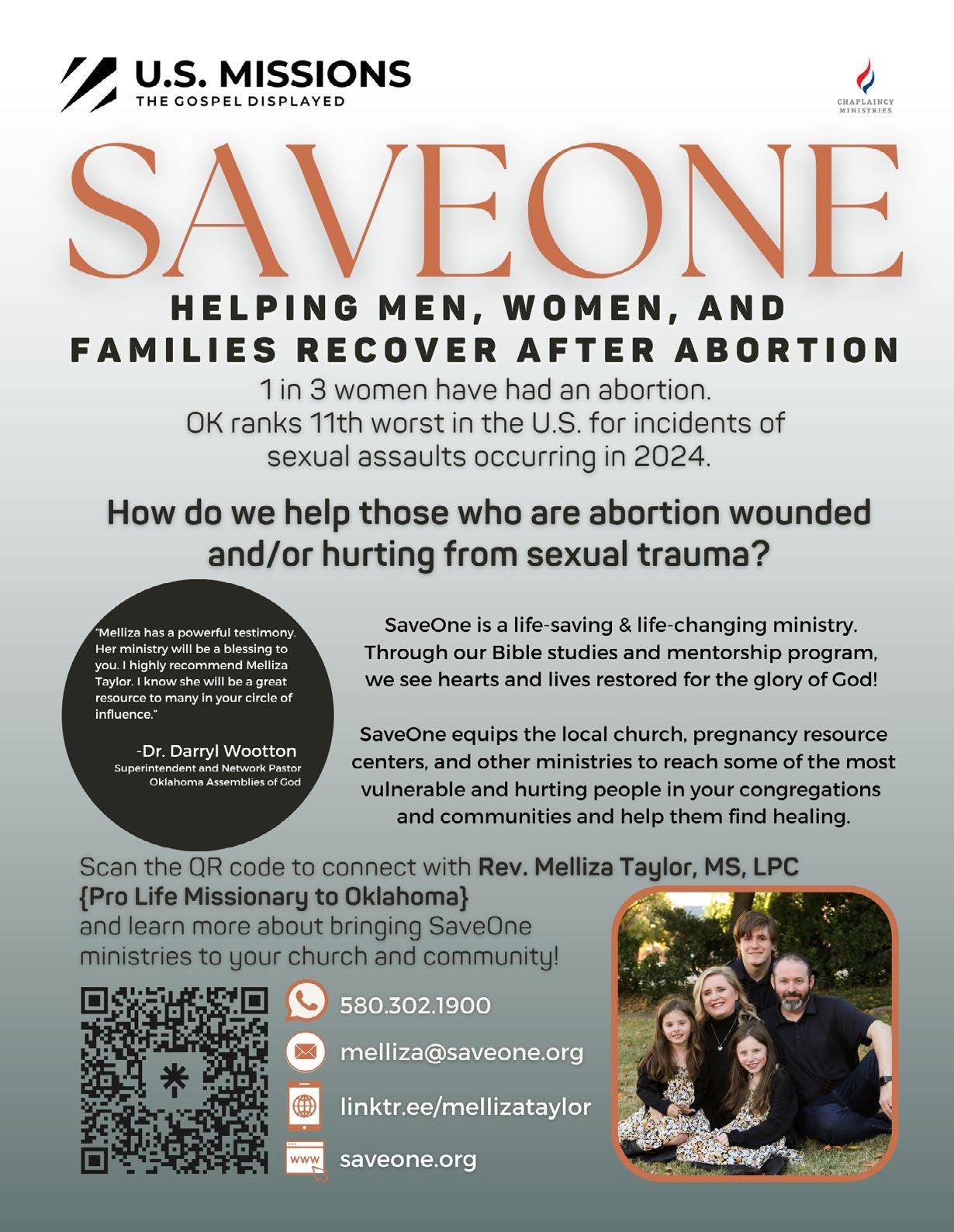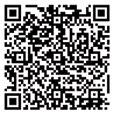

Media & Technology The Issue


Oklahoma Outlook
Oklahoma Assemblies of God
The
Publisher: Dr. Darryl Wootton
Editor: Phil Taylor
Designers: Jayson Evans, Chris Ainsworth
Contributors: Dr. Darryl Wootton, Dr. Charles Kinman, Mark Forrester, Cody Phillips, Blake Edgmon, Jayson Evans, Penny Meadows
Advertising: For advertising inquiries, email outlook@okag.org.
www.okag.org

Upcoming Events
NOVEMBER
Global Workers Appreciation Month November 1-30
OSOM – Locations 1,2,3 November 1
Light for the Lost Night November 2
Women of Valor Conference November 8
Youth Pastors Retreat November 8
OSOM – Locations 4,5 November 8
Hispanic School of Ministry, McAlester November 8
Century Leadership Roundtable November 20
Made for This November 21-22
DECEMBER
Evangelist Appreciation Month December 1-31
OSOM – Locations 1,2,3 December 6
Heritage Senior Christmas December 6
Hispanic Ministers Christmas Party December 6
OKAG Faith Promises Due December 12
OSOM – Locations 4,5 December 13
Hispanic School of Ministry, McAlester December 13
Ministerial Credentials Renewal Deadline December 31
JANUARY
OSOM – Locations 1,2,3 January 3
Hispanic School of Ministry January 3
OSOM – Locations 4,5 January 10
OKAG Women Sectional LIFE Rallies January 16
Speed The Light Rallies January 18
Century Leadership Roundtable January 22
OKAG Girls FLOURISH Conference January 24
ACMR Deadline January 31
FEBRUARY
Network Tour, Section 12 (AM)
February 2
Network Tour, Section 11 (PM) February 2
Network Tour, Section 8 (AM) February 3
Network Tour, Section 5E/5W (PM) February 3
Network Tour, Section 9N/9S (PM) February 5
OSOM – Locations 1, 2, 3 February 7
Hispanic School of Ministry February 7
Network Tour, Section 2 (AM) February 9
Network Tour, Section 3 (PM) February 9
Network Tour, Section 4 (AM) February 10
Network Tour, Section 7 (PM) February 10
Network Tour, Section 6 (AM) February 12
Network Tour, Section 1 (PM) February 12
OSOM – Locations 4,5 February 14
NextGen Conference February 19-21
OKAG Women of Valor Retreat February 20-21
Network Tour, Section 10 (AM) February 23
OKAG Hispanic Conference February 27-28


Pastor From Our

One microphone, an organ, and a mimeograph machine were all the media and technology you needed to lead a church in the 1950s. A sighting of a Shure 55 Unidyne (the Elvis Microphone), a Hammond B3 organ, and an Albert Blake Mimeograph printer were confirmations that your church was tech savvy in that era. You were cutting edge if you had two Leslie speakers for the Hammond!
Our Assemblies of God church movement was born out of the Revival fires of Azusa. We have always been a Spirit-filled fellowship that utilized technology to advance the Gospel. Technology is neither good nor evil. It is simply a tool that we must carefully utilize to uphold our Biblical principles. Let’s glance at some of the history, benefits, and consequences of church media technology.
Throughout history, the Church has always utilized technology and media. Early Christians used their preferred artistic ‘medium’ to express their gifts. An art medium is the material or substance an artist uses to create a work of art. Artisans created oil paintings, bronze statues, and stained-glass displays centuries ago to illustrate the stories of the Bible. Although there have always been historical technological advances, much church technology stayed relatively the same until the Gutenberg Press was invented in 1440. Previously, artists produced media viewed mainly by a limited audience of one or a few individuals at a time. After the printing press, ‘mediums’ turned to ‘media.’ Mass media presented the Gospel to many people simultaneously through the printing press and later through broadcasts. Since the time of Gutenberg, technological advances have expedited beyond anyone’s wildest imagination.
Within our Assemblies of God history, our churches have always utilized technology to proclaim Jesus. In the 1920s to 1940s, many local churches connected with local radio stations to broadcast the Gospel over the airwaves. Pastors submitted their sermon outlines to local newspapers, which would often provide free space for this noble cause. A technologically savvy missionary might bring in a slide projector or a 16mm film projector. Although no pastor in the 1950s encountered the Microsoft Windows ‘blue screen of death’ on their computer, an occasional mission movie did get eaten by a malfunctioning projector.
Technology always creates opportunities and hazards. In the early 20th century, mimeograph machines provided churches with opportunities for mass-printed tracts and flyers. However, with mass printing, discipleship became less personal. In the mid-20th century, evangelists brought the Gospel to television and saw much fruit, but church consumerism also grew in that era. Today, we wrestle with the tradeoff between the convenience of live streaming and the accountability of attending in person. There is a tension between the quickness and ease of artificial intelligence versus the time and investment it takes to prayerfully give birth to an anointed sermon.
Technology and media are tools. We need to use them to fulfill the Great Commission. However, our use of technology should always be rooted in the fruit of the Spirit and the integrity of Holiness that our God requires. Americans spend over two hours on their electronic devices daily, consuming social media. If the world is on social media, let’s share the Gospel there! However, as Shepherds, we must also safeguard our parishioners from the hazards of social media. There are two sides to every coin. Let’s be proactive and tech savvy while also being standard bearers for God’s Holiness and shepherds of His flock.
Thirty years ago, many churches started utilizing overhead projectors in services to increase their ability to sing new choruses. Hymnals could not be published as fast as songs were being written. Some will remember the inward chuckle that the occasional crooked or upside-down transparency produced. Twenty-five years ago, churches upgraded to multimedia projectors utilizing computer slides for worship. Most churches could not afford expensive projectors. The technology was a significant advancement. However, due to minimal budgets, less expensive projectors were purchased that required very dim room lighting. An entire generation grew up in many dimly lit sanctuaries. Today, many of them still feel more comfortable in a lowered light atmosphere. Anytime I hear an elder saint complain about dim lights, I inwardly smile while thinking, “You should have given more when your church took up the offering for that cheap projector years ago.” I am not arguing for dim lighting or bright lighting. I am simply stating that oftentimes our short-term decisions have long-term effects. Let’s pray about new technology before we run to embrace a new fad. The danger is not
using technology; the danger is letting the technology use us.
Whether your church is on the cutting edge of technology or still resembles the church described in the 1950s, let’s all keep our hearts pure and our focus set on the Great Commission. The church is not called to keep up with trends but to keep in step with the Spirit. When we reach heaven, we will not get extra credit for how many media badges we earned through our journey in ministry.
Let me close with this verse from the Wootton International Amplified Version.
‘‘Not by might nor by power, not by Planning Center nor by ChatGPT, not by Tithely nor Realm, not by Facebook nor Snapchat, not by Slack nor ProPresenter, not by in-ear monitors, nor by MultiTracks, BUT BY MY SPIRIT,’ SAYS THE LORD ALMIGHTY.”
Remember, media and technology can reach the eyes and ears, but only the Spirit of God can transform a heart. Let’s use every tool available in a way that honors God to share the love of Jesus with the least, last, and lost.
Better Together,

Dr. D.E. Wootton Superintendent
Oklahoma Assemblies of God
Howarth, Josh. 2023. “Worldwide Daily Social Media Usage.” Exploding Topics. November 28, 2023. https://explodingtopics.com/blog/social-media-usage.

Our Mission Networking together to better share the love of Jesus with the least, last and lost.
Our Vision
A healthy Church in every Community
Our Values LOVE God together LIVE healthy lives together
LEAD healthy churches together LAUNCH healthy ministries together


Digital Media and the
Church
3 Cautions and 4 Encouragements
By Mark Forrester
A few years ago, I found myself at the world’s most militarized border — the infamous demilitarized zone (DMZ) at the 38th parallel between North and South Korea. Looking beyond the barbed wire, guard shacks, and patrols, the hills and villages of North Korea were clearly visible. Red triangular signs dotting the hillside signaled the presence of land mines. Most overwhelming at the site, perhaps, was the broadcast barrage of propaganda.
At one point, my guide stopped and said, “I think we’re hearing the North right now.” After pausing a few more moments, she smiled nervously. “Yes. That’s definitely the North.”
From the South, loudspeakers blasted trendy K-pop tunes onto the North Korean hills. From the North, music and passion-filled speeches rushed across the narrow DMZ and into the border town of Paju, South Korea.
In between, we found ourselves in a confusing mesh of sounds: angry and calm, classical and contemporary, oppressive and progressive.
Do you ever feel in between two conflicting cultures? Technology has a way of immersing us into a high-paced, divisive culture where algorithms can have an inordinate amount of control over our perspective. We’re also citizens of another culture — the Kingdom of God.
Paul seems to have had a crystal-clear view into our current social media culture when he described the works of the flesh. Even in his context, he called these actions “obvious.” “The acts of the flesh are obvious: sexual immorality, impurity, and debauchery; idolatry and witchcraft; hatred, discord, jealousy, fits of rage, selfish ambition, dissensions, factions, and envy; drunkenness, orgies, and the like. I warn you, as I did before, that those who live like this will not inherit the kingdom of God” (Galatians 5:19-21).
He goes on, though, to lay out the clear contrast that a Spirit-filled life demonstrates. Again, what he writes is incredibly relevant advice for today’s culture. “But the fruit of the Spirit is love, joy, peace, forbearance, kindness, goodness, faithfulness, gentleness, and self-control. Against such things there is no law. Those who belong to Christ Jesus have crucified the flesh with its passions and

desires. Since we live by the Spirit, let us keep in step with the Spirit. Let us not become conceited, provoking and envying each other” (Galatians 5:22-26).
In today’s world of increasing polarization, it’s easy to feel bombarded by competing, conflicting, even hostile messages. News headlines are increasingly difficult to decipher amid inherent bias among reporters and news organizations. Reading through social media news feeds can alienate people. In personal relationships, cultural tensions and hostilities arise in workplace conversations, impromptu encounters, and even at the family dinner table. Simple statements, which could be interpreted in multiple ways, create controversies never intended. Some social media users seem determined to live in a perpetual state of conflict, thriving on the energy of debate.
How can a ministry thrive or even survive in such an environment?
Just on the other side of the North Korean border town of Paju sits the Osanri Prayer Mountain, operated by the world’s largest church, Yoido Full Gospel Church (YFGC). The day after being at the DMZ in Paju, I took the hourlong shuttle from YFGC in Seoul to the Prayer Mountain.
When walking through the mountain facilities, one can hear literal cries of prayer echoing off the Korean hills.
Here, too, is a barrage of sounds along the contentious Korean border. But this is different.
Unlike the conflicting sounds along the DMZ, the prayers at Osanri rise in concert — from believers praying in multiple chapels, praying in hundreds of individual prayer grottos, and even praying while roaming the hills.
As I sat on the hillside in the still chilly Korean air, hearing the cries of saints from various nations, I noted the contrast. Unlike the two loud competing voices the previous day, here various voices cried out in the unity of the Spirit.
Our challenge in a polarized world is to stand out as voices in clear harmony.
As believers, though, how can we stand above the noise and live out the goals of God’s Kingdom while embracing the technological tools available to make that happen? I’ve gathered three cautions and four encouragements to help you navigate this rocky terrain.
THREE CAUTIONS
1. DON’T MAKE AN IDOL OF TECHNOLOGY
In Numbers 21, the people of Israel are found complaining against God and against Moses as they wander in the wilderness. At this point, it’s a familiar scene. A sort of pattern of crisis, complaint, judgment, intercession, and deliverance. Here, God sends venomous snakes among them, leading to many deaths. When Moses prays, God gives him specific instructions. Exodus 21:8-9, “The Lord said to Moses, ‘Make a snake and put it up on a pole; anyone who is bitten can look at it and live.’ So, Moses made a bronze snake and put it up on a pole. Then, when anyone was bitten by a snake and looked at the bronze snake, they lived.”
It’s a scene of miraculous provision!
When we fast-forward several hundred years to the reign of Hezekiah, 2 Kings 18:4 gives us a little more information on what happened to the bronze serpent. Hezekiah has it smashed into pieces! Why would he destroy such a remarkable artifact? After all, didn’t God command this object to be made? The passage makes it clear why Hezekiah took this drastic step. The people had given a name to the serpent, calling it Nehushtan. Beyond that, they were worshiping it and burning incense to it.
A visual tool that God had provided as a means for ministry had ended up becoming an idol in and of itself!
The story of Nehushtan teaches us valuable lessons.
First, God can use “things” as a means of ministry. There was nothing evil about the bronze. There was nothing evil about the shape in which it was crafted. In fact, Jesus referenced this same bronze serpent as a foreshadowing of His own death in John 3:14, saying, “Just as Moses lifted up the snake in the wilderness, so the Son of Man must be lifted up.”
Second, even tools God has used and commissioned can become idols. This is a theme commonly repeated in the Bible. Even in the same wilderness wanderings, Exodus 12:35-36 tells us that the people of Israel stripped the Egyptians of their silver and gold and wealth. One assumes it is the same Egyptian gold that God had provided, which soon becomes the golden calf. It also appears to be the same Egyptian gold that is used to create the ark of the covenant, the menorah, and the instruments of the tabernacle. What’s the difference? Was the gold evil? Certainly not. The way it was used became the critical distinction.
When we hear the evils of digital media and technology, it’s easy to draw the wrong conclusion and assume that the technology itself is evil. The fact is that the same technology can be used to advance the Kingdom of God in significant ways. Just like the bronze serpent and the Egyptian gold, it’s how we use these tools that makes all the difference.
2. DON’T SACRIFICE FUNCTIONALITY FOR FLASHY TOOLS
I worked closely with George O. Wood when he was general superintendent of the Assemblies of God. Anyone who knew him could instantly recognize his sage wisdom. He also had a lesser-known trait — a desire to stay on the cutting edge of technology. In fact, he would often encourage pastors to be “on the cutting edge and not the lagging edge of technology.”
He would readily admit, however, that there were times when his quick acceptance of the latest technology would have some less than desirable results. He told a story of his days as a pastor in Costa Mesa, California. The projection of lyrics during a worship service was not yet common. He invested in a scrolling ticker-type display to place at each side of the auditorium. The challenge, though, was timing the scrolling ticker to the tempo of the music. He laughably related the confusion in the congregation as all the heads bounced from side to side quickly, just trying to keep up with the words. They were soon taken down.
Just because something is new and flashy doesn’t mean that it will be helpful for ministry. In fact, some trends may actually hinder effective ministry. Be mission-focused. Make sure the tools you are researching can enhance your mission without compromising.
3. DON’T MAKE COMPROMISES FOR SAFETY
Some technologies may look promising for missional effectiveness, but they pose key risks for safety. For this reason, certain apps or resources you may be considering may need careful evaluation from an attorney.
The most notable example of this would be apps, tools, or social networks that allow private, encrypted, or expiring messages between adults and minors. Work closely with your attorney or insurance company to establish policies regarding the use of technology and messaging. If you don’t know where to begin, consider looking at your local school district’s relevant policies. There are many tools your students are likely already utilizing within their school district for safer messaging, where parents or other parties can see or access the messages being shared.
FOUR ENCOURAGEMENTS
1. MAKE HIS NAME FAMOUS
The inherent risk of social media and technology is that we would begin to build our own name or ministry “brand” rather than the name of Jesus.
The story of the Tower of Babel is especially relevant today. They used new technology (i.e., brick laying) to glorify themselves. Genesis 11:3-4 says, “They said to each other, ‘Come, let’s make bricks and bake them thoroughly.’ They used brick instead of stone and tar for mortar. Then they said, ‘Come, let us build ourselves a city, with a tower that reaches to the heavens, so that we may make a name for ourselves; otherwise we will be scattered over the face of the whole earth.’”
The unity they were looking to achieve through technology was not God-honoring. The purpose of their efforts was to bring glory to their own name. Interestingly enough, this false unity resulted in confusion and chaos. The genuine unity of Acts 2, however, led to a powerful move of God.
Anytime our focus shifts from exalting the name of Jesus to exalting our own name (even our ministry’s name!), we’ve lost perspective. If our goals become tied to follower count, downloads, and video views in and of themselves, we’ve drifted from our mission. Don’t get me wrong, some of these metrics can be measures of specific ways we’re reaching people with the gospel. That’s helpful. Don’t confuse yourself, though, into thinking that these vanity metrics are always tied to spiritual outcomes. Use the tools and technology that you have to exalt the name of Jesus and advance the Kingdom of God.
2. BE SENSITIVE TO THE SPIRIT
Go where the Spirit leads you to go and do what He leads you to do. Don’t let fear of technology keep you from using it for Kingdom effectiveness. Ministry in any divisive context can be challenging yet rewarding. Social media ministry is no exception.
As in the story of Jonah, it’s tempting to run away from the places God calls us to serve. Jonah resisted speaking to the people of Nineveh (Jonah 11:1-3). Perhaps fear, hatred, or even pride caused him to run.
The heart of Christ, however, shows love unconditionally and never avoids dangerous or uncomfortable situations. Time and time again in the gospels, we find Christ in such situations, breaking cultural barriers to reach an individual with a message of hope.
How?
• Be a voice of hope in your church, in your community, and even in your home.
• Bring the light of Christ into the darkness.
• Seek ways to become involved in your community in a positive way.
• Be a beacon of hope in the middle of a rancorous social media environment.
Perhaps the conflict you may end up facing will be a God-ordained opportunity for ministry. A word of encouragement to a social media follower may change his or her emotional trajectory. A “soft answer” may turn away the irrational wrath of a family member (Proverbs 15:1).
More than two billion people are active on social media. For many of them, social media could be the first voices and the last voices they encounter each day. Imagine the impact we could have on a person’s first waking social media interaction if we’re led by the Spirit.
No, social media is not a “safe place” for those looking to avoid conflict. But the work of a successful missionary has never been confined to what is safe. Look anywhere in the world where you see a work of God, and you will find the story of those who have risked greatly.
Social media interactions are no exceptions. Don’t run from the place God has called you. Be a light to those around you. We can have no impact where we fear to go. Without risk, there is no reward.
Peak hours for social media usage have held steady at around 9 to 11 p.m. Most studies conclude that this peak happens as young couples put their children to bed and may be relaxing in front of a television screen.
Users will see plenty of messages to conclude their day: partisan headlines, rants from the offended, people lashing out in hurt, and pictures that portray a perfect life. What will your message be to people at this critical time in their day? Choose to be a voice of hope in the chaos.
Approach your own online posting and personal interactions prayerfully. Ask God to give you wisdom and courage as you face others who may have hostile attitudes. Pray that your conversations will be led by the Spirit and that your social media posts will lead people closer to Christ.
3. USE CUTTING EDGE TOOLS STRATEGICALLY
Stay up to date on the latest tools to know what may be helpful for your ministry context. You’ve heard the axiom, “Fish where the fish are.” Your Kingdom effectiveness can be greatly enhanced utilizing the latest tools and technology.
It’s clear in Scripture that God anoints and equips people for tasks related to creativity and technology. Most notably, we can see this in Bezalel. In Exodus 31:3-5, God tells Moses, “I have filled him with the Spirit of God, with wisdom, with understanding, with knowledge and with all kinds of skills—to make artistic designs for work in gold, silver and bronze, to cut and set stones, to work in wood, and to engage in all kinds of crafts.” Perhaps there are those in your congregation who have a God-given ability for creative design, coding, communications, or technology. Empower them for ministry within the calling for which God has equipped them.
Consider the 80-15-5 model in your approach to digital media and communications. This model focuses 80% of your team’s digital communications efforts on the types of communications that already resonate well with your audience. Spend 15% of your team’s digital communications efforts on where you see your audience growing. Then, focus 5% of your efforts on experimenting with forms of communication outside of the box. For example, your team may be well-equipped for producing beautiful shareable images which seem to be performing well on social media. This is where you would continue to focus 80% of your efforts. Perhaps you’re less equipped in the field of video production, but you see your audience growing toward that. Begin focusing 15% of your efforts on growing that, while maintaining what continues to work. Use the other 5% to test new platforms or types of communications you have yet to try. Many communicators see that the 5% can quickly become their new 80%!
4. DEMONSTRATE THE FRUIT OF THE SPIRIT
A Spirit-led life always points to Christ. After sharing an article on Facebook, I received a private message from
someone in Eastern Africa. He had a spiritual struggle directly related to the subject matter in the article I had shared. He needed prayer. Within a couple of hours, AG World Missions connected him to someone who could personally help him through his struggle. This isn’t a unique case. God can use any means of communication to bring a message of hope and healing.
In part, walking in the Spirit means that we remain open and willing to share His message in all settings. When we do, He is faithful.
Walking in the Spirit also means that we reflect the true nature of a Spirit-empowered life — the fruit of the Spirit. Will the fruit of our social media and other interactions be contention, strife, or anger? Or will the world see us as being primarily characterized by love, joy, peace, patience, kindness, goodness, faithfulness, gentleness, and self-control (Galatians 5:22-23)?
Ask God how you can show hope and kindness in a hostile environment. It could be mailing an encouraging note to a local business owner, sending flowers to a friend facing anxiety, or even spending a few more minutes of personal time listening.
Pray that the Holy Spirit will work in your heart to bring forth His fruit in your life. Ask God to help you maintain a spirit of love in what you say in person and online. Believe that the Lord will provide opportunities for the messages you post to impact the lives of readers when they need them most.
Be confident in the calling that God has placed on you, your church, or your ministry. Keep in mind that technology is not the mission — it’s a means to fulfill that mission. We have a rich heritage of embracing technology in the Assemblies of God to further the gospel. Early AG leaders like E.N. Bell and J. Roswell Flower were embracing the technology of their time. They operated printing presses to spread the message of Pentecost in the most efficient way they could. The early Assemblies of God offices were built around these printing presses. Through leaders like C.M. Ward, radio technology was used to reach into the living rooms of millions of Americans. Following World War II, the Assemblies of God purchased military aircraft to reduce the time of getting missionaries to the field from weeks to days. AG missionaries have used satellites, live streams, augmented reality, virtual reality, and more to reach people with the gospel.
As we continue to move forward in what our founders prophetically called “the greatest evangelism the world has ever seen,” let’s leverage every appropriate technology to make this happen while keeping our mission firmly in place with the Holy Spirit as our guide.

Mark Forrester is the chief communications officer for The General Council of the Assemblies of God. A graduate of Lee University and the Assemblies of God Theological Seminary, Forrester resides in Springfield, Missouri with his wife, Janine, and two children, Greyson and Charlotte.


Subduing Technology
By Rev. Charles W. Kinman, PhD, LMFT (retired)
“For the word of God is alive and active. Sharper than any double-edged sword, it penetrates even to dividing of soul and spirit, joints and marrow; it judges the thoughts and attitudes of the heart. Nothing in all creation is hidden from God’s sight. Everything is uncovered and laid bare before the eyes of Him to whom we must give account.” (Heb. 4:12-13)1
One can hardly take a breath without some involvement with technology. It wakes us in the morning and serves us throughout the day with tools to accomplish something that may not be possible otherwise. Our creation of technology is as much a part of subduing the earth as plowing a field or taming a horse. How we choose to use it shapes our spiritual development and integrity. Both are indispensable for honorable, anointed service to Christ.
For our spiritual development, God designed us to be relational beings who gain spiritual maturity in Christ Jesus and with others (II Pet. 1:3-10; Phil. 2:1-11). Relationships are not meant to be stagnant. They are designed by our Maker to grow us like a flourishing tree by a river. As believers, imitation of our Heavenly Father honors that which He gave to us. It seems natural for children to learn by imitation of their parents. Relationships, like marriage, exercise purposeful actions for progressive knowledge of one another, intentional avoidance of calamity from
sin, and to be guided by God’s will. This all takes place in our mind and is confirmed in our choice of actions within relationships.
My field of study is neuroscience applied within our theology. The abundant research from this science shows God designed the brain as a “social organ” that constantly builds itself through interactive relationships. It begins with how infants develop their first sense of trust based on their caregivers, referred to as attachment. How these experiences go will influence a person’s beliefs and significant relationships into adulthood. “Attachment experiences directly affect the development of the brain…for the infant and young child, attachment relationships are the major environmental factors during its period of maximal growth.”2 God created felt closeness for a baby’s first connection to another by looking into her mother’s gaze while feeding at her breast. Only through relationship can we know ourselves in order to know others.
Technology can distract us from our needed spiritual development. The number of electronic devices we use in a day is mind-boggling. There is a tool for everything. I could fiddle with the many technological machines that surround me literally 24/7. They need more attention than a pet and a yard combined. I must have two miles of charging cords and forty additional plugs to manage them. Our televisions certainly consume a significant amount of time. But like anything beyond moderation, these essential tools for surviving the 21st Century can distract us from the vital time we need to gain attachment to our Lord.

Do not get me wrong; I like my tools and what I can accomplish with them. However, the intricacies of relational connection are observed and felt by one’s undistracted presence (e.g. Mother’s gaze; father’s approval; creativity). That presence enables two minds to attune to similar meanings shared. They connect; they “get” one another. The satisfaction generates a protein in the brain that builds new neuronal connections and memories, increasing one’s genuine familiarity with another.
We strive to create a close family to fulfill this very purpose for God’s joy. By learning this process of love, we bring glory to our Lord (John 17:10), and He gives the Bread of real life (John 6:63). However, in ministry, family connection time often submits to the convenience of technology and schedules. Our vision for relational development with the Lord and family is merely functional or secondary. Ministry families connect around shared ministry, but it is the lack of concentration that matters. Our divided attention impedes the relational bonding process. Simply, how do you feel when you are sharing something important, and you notice the other person is looking at his or her phone? Regardless of one’s excuses, there is a disconnection. Or when we invite youth to “follow Jesus,” might they assume it must be like “following” a social media personality?
Like infants, we are to meditate on our Father’s gaze and His word so He can develop in us an undistracted presence, attunement, and resonance.3 Attaching to Him, we may learn to “abide” like branches deeply affixed to the
Vine (John 15:1-8). Paul expected people to change their choices once they believed the everlasting hope in Jesus (Eph. 4:1). In Romans, chapters six and seven, he describes internal struggles of the mind to discern and resist distractions to knowingly sin. He shared the mind’s power to choose the trajectory of a soul over time (Rom. 6:16; Heb. 2:14-18).
He used the words “Christ’s love compels us” (II Cor. 5:14) and “I urge you” (Rom. 12:1; 15:30; 16:17; I Cor. 16:15) to express the earnest emotion of concern for his message to be heard. I wonder how emotional Paul Revere was as he raced through the streets, crying out that the British were coming? The Apostle expressed a similar urgency to inform his readers of the importance of continually maturing spiritually (Heb 6:1-3; 11:6; II Pet. 1:3-9). We are not to be so distracted by the amazing creations of the creation that we miss the valuable time to connect in deep closeness to our heavenly Father!
1. HAVE REGULAR, UNDISTRACTED TIME THAT YOU ARE DISCIPLINED ABOUT KEEPING WITH THE LORD.
Habit strengthens learning. Karen set her watch to play Ode to Joy at nine in the evening. She would stop what she was doing to sit down with the Lord in prayer and study. Reading a book, especially the Bible, stimulates activity in nearly all regions of the brain to form mental imagery for every word. Various attractor states (clusters of similar memory) reinforce connections, strengthening
overall memory. The stronger these neural connections, the healthier the mind. In addition, a greater sense of creativity and understanding of complexity emerges.
2. FAST OCCASIONALLY FROM TECHNOLOGY.
Be present in the physical world with a hands-on hobby or interaction. Children who stare at their phones while driving with their parents miss a tremendous amount of three-dimensional brain stimulation, looking out the window, versus the two-dimensional view of a phone. As well, the technological distraction pilfers relational interaction with parents to talk about what the child sees or feels about matters. Likewise, for the social interaction of grocery shopping. To be fully present, it is helpful to be without technological distractions.
3. JOURNAL AND REVIEW
Having to generate symbols (i.e., words) develops stronger imagery for memorizing. For example, when reading, one must use multiple regions from both hemispheres of the brain. “Integration that recruits multiple layers of circuits may create the strongest complex states as it links various forms of representations throughout the brain and between brains.”4 Writing something down, even partially, strengthens one’s recall. Review and reflection (e.g., meditating) permit a flow of interaction with God’s word for His people, constructing deeper meanings inspired by the Holy Spirit.
I need not list the amount of ungodliness accessible by technology that tests our spiritual integrity. We know there are no boundaries on the internet, except those applied by the individual. One must consider the complex nature of applying a theological ethic in such an environment. How are we to be holy? How do we put moral knowledge into practice (Matt 7:24-27)? What is the relation of technology to sin (Mk 9:47)? Who determines the boundaries for our use of technology (Ex. 15:26)? Consequently, the individual must give an account for the answers to those questions. Christ issued stern warnings in the parables of Matthew 25. We are to soberly keep watch, do something with what we are given, and be empathetically compassionate to those in need, as if unto Jesus Himself.
So, what is it that God observes when He searches our hearts? From the above passage, it appears the Word of God provides a lantern of discernment illuminating the contents of our souls, our thoughts, and our actions. The Holy Spirit seems the watchman and translator of the imaginings of our mind in reflection of God’s character. It tells of God’s unfathomable involvement in our most inner being. He asserts His power in the invisible parts of our lives, where the influences of the technological world can also affect us.

The early history of the word “heart” shows it to represent both a physical organ and “the seat of the emotions and feelings, of the instincts and passions…joy and sadness, strength and fear, love, hatred, and anger.”5 In the Old Testament, leb and lebab (used later from Isaiah on) referred to both the literal and metaphorical. The literal form means a source of physical life and strength and the refreshing of life, especially nourishment from food (Gen. 18:5; Jdg. 19:5; I Kings 21:7; Isa. 1:5; Ezk. 36:26).6
The metaphorical references reflect the various dimensions of the whole person’s feelings, thinking, and willfulness. The word refers to people’s emotional feelings like joy (I Kings 8:66; Eccl. 11:9), fear (Deut. 1:28, 5:29; I Sam 12:24), love (Gen. 34:3; Deut. 6:5-6, 30:6; Song. 3:2), and sorrow (Gen 8:21; Neh. 2:2; Eccl. 7:3; Ps. 13:2). According to these Old Testament writers, each of these emotional expressions generate from one’s heart or internal state of being.
“Heart” is also used frequently in a psychological sense, as the center or focus of a person’s inner personal life. “The heart is the source, or spring of motives; the seat of the passions; the center of thought processes; the spring
of personal conscience.”7 Jesus spoke of the heart as the place where innocent purity sees God (Matt. 5:8), and sin first forms (Matt. 5:28). He distinguished that out of the heart malicious thoughts and actions emerge (Matt. 15:19), and from which forgiveness is given (Matt. 18:35). He declared we all must love the Father with “all” our heart, soul, and mind (Matt. 22:37). It is comprehensive. The “heart” is the place of faith; a place we meet to know and be known.
It is important to say that what we take in from the world sways the shape of our heart and mind. For example, because most actions draw from various regions of the brain and different levels of memory, images and physical sensations from viewing pornography contribute to our thinking process. Such memory may not be obvious, but it influences, like a small amount of yeast in bread. It changes the chemistry of relational connections. Most spouses know something is off when the other is hiding something. Israel was to be separate from surrounding nations to prevent the corruption from deceptive ideologies that would pollute their relationship with God.
This enlightens many of the distinctions Christ made when He claimed, “You have heard it was said…But I tell you…” Performing duties, avoiding criminal behavior, and sexual faithfulness were not just about outward physical appearances; people were to learn it as a matter of the heart. Jesus scorned religious performance. As God’s people, our heavenly identity is to shine outward for those blinded in darkness (II Cor. 4:4-6; Matt. 5:14).

Paul speaks of the heart as the spiritual battleground. For him, the primary fight amid “heavenly realms” takes place in one’s mind against “spiritual forces” (Eph. 6:1018). He commanded that believers have a strong grip on the word of God to remember the power of His promises and His intent. The power to walk with God resides inside of us. “Paul uses other expressions, such as mind, soul, and spirit, to augment the conception of man; but on the whole it may be said that the NT word kardia reproduces and expands the ideas included in the OT words leb and lebab.”8
From this evidence, we can easily conclude that biblical authors’ references to the heart express an inner reflection of emotional sensibilities and cognitive resolutions. They reveal that we are to have an internal dimension that controls outward actions. “We must always be willing to demonstrate the vitality of our faith by acting on the basis of what we believe.”9
Our personal behavior is less about what we do and more about the way we will be in our hearts. If we have violated our own conscience, it will change the dynamic of our relational interactions. Ask yourself, would your actions with technology and the Internet bring honor or embarrassment to your family if made public? Or is there conviction of your conscience when examined in light of His word?

Our internal thought process controls our actions, which will be reviewed in the bright light of His word, character, and love. Our spiritual development and our spiritual integrity require that we have clear priorities about our subduing of technology. How will those priorities encourage our honorable, anointed service to Christ? The eternal result will depend on what our Lord Jesus finds when He searches our hearts. Dr. Kinman recently retired from 30 years as a pastoral marriage and family counselor and 20 years as a professor at Northwest University. He is a nineyear military veteran and now serves the Oklahoma district as an encourager. The Kinmans live with their family in Newalla.
1. This Scripture reflects some complex invisible technology examining our mind.
2. Siegel, D. J. (2012) The Developing Mind: How relationships and the brain interact to shape who we are, 2nd Ed. New York: the Guilford Press. pp. 112113.
3. Kinman, C. W. (Winter 2024). Empowered Together. OUTLOOK, OKAG, Oklahoma City, OK. p. 6.
4. Siegel (2012), p. 371.
5. Sorg, T. (1976). “Heart” in The New International Dictionary of New Testament Theology, Vol. 2. Editor: Colin Brown, 1976. p. 180. In the NIV, words for heart are used seven hundred and twenty-five times throughout the Bible.
6. Ibid. p. 181
7. Brandon, O. R. (1984). Heart. Elwell, W. A., Ed. (1984) Evangelical Dictionary of Theology. Grand Rapids, MI: Baker Book House, p. 499.
8. Ibid. p. 499.
9. Youngblood, R. (1998) The heart of the Old Testament: A survey of key theological themes, 2nd Edition. Grand Rapids, MI: Baker Books. p. 93.


It is Time to Start a Podcast?
By Cody Phillips
I recently attended a small group hosted by a couple in our church. One question broke the reservoir for unending references and conversations: “What music did you grow up listening to?”
This may seem like a basic question for any “icebreaker” in a small group, but it’s not a particular band or song that initially comes to my mind. Instead, my mind jumps to Paul Harvey. While traveling to a specific destination - Walmart, league practice, the off-site family dinner, or even Wednesday night church, my dad would keep my brother and me inside the truck until Paul Harvey had finished “the rest of the story.” My mind always jumps to talk radio when this ice-breaking question is asked. If you step into my car, it’s a 50-50 chance that talk radio is playing on the dial or a podcast is coming through the aux cord. For better or for worse, I have adopted my father’s trait, but instead of Paul Harvey, I need to hear “the rest of the podcast.”
If you haven’t found your binge-worthy pod just yet, don’t worry—it’s only a matter of time because podcasts aren’t going anywhere. The podcasting landscape has experienced exponential growth in recent years, leading to
a diverse array of podcasts spanning various topics and genres. As of 2025, ~4.5 million podcasts are currently available worldwide, reaching over 550 million people a week.
As pastors and leaders, our eyes should pop out of our sockets. You can reach this very reachable people group with extra content outside of your livestream and the recorded sermon you upload from Sunday. The question is: “Should I start a podcast?” Before we dive into creating content we think the world needs to hear, let’s ask ourselves this question: WHY?
We must ensure that our “why” is pure and intentional. Podcasts can be an incredible resource for learning, encouragement, and exposure to solid teaching, but we must produce content from a place of pure intention, working to build the Church, not our own platform. I’m not too naive to understand that you want to grow your number of listeners, but it cannot be at the expense of edifying and discipling the body of Christ. When your approach is to build an audience and not build the people in your community, you’ve potentially doubled down on sharing your opinions and creating entertainment. No offense, but you’re probably not as entertaining as you think. Leave the entertainment to entertainers and become a pure shepherd who leads, nourishes, challenges,

and tends to the needs of the flock. God doesn’t call His people to choose a tribe of teachers or podcasters that they like best (1 Corinthians 1:12–13), but to submit to real shepherds who care for their souls (Hebrews 13:17). We live in a time when a person’s faith can become a personalized and consumer-driven experience – that’s something we should be aware of, but not take part in.
When I suggest that you be intentional about your podcast, I don’t mean simply being consistent. To be intentional in this endeavor, ask yourself if this is moving
the mission of our church community forward. A church podcast can easily drift into just being “content,” unless it’s intentionally tied to its mission. Start by asking: What is our church’s mission statement and vision? Then, make sure every episode supports it directly or indirectly. Podcasts are often one-directional – the listener receives content, but cannot engage in dialogue, ask questions, or practice any kind of “one-another-ing”. To be fair, it should be our intent to create those environments for our people to follow those commands (Romans 12:10, Galatians 5:13, Colossians 3:16). The church is designed for interaction, service, and growth together (Ephesians 4:1116), and this should be true for any discipleship method or material. It should remain intentional by constantly encouraging the body to gather together on Sundays and throughout the week. Without the local church, a Christian can miss the chance to serve, give, love the poor, bear burdens, and show Christ to the watching world (John 13:34-35, Matthew 28:19-20). The church — it’s a people sent on mission together. Be intentional that this will not be a place to get on a soapbox every week. Strive for a podcast to build the community of God and move the mission (and not your brand) forward.
I had the opportunity to connect with three different pastors within our Oklahoma Assemblies of God Network. All three of these pastors host their own podcasts that supplement the teaching on Sunday morning and the gathering of the saints. What I love about each of these podcasts is that they are all intentional, but they are intentional in different ways. They have never lost sight of the purity of what they’re shooting for, which is to equip and train up disciples.
• Pastor Jordan Dunn and three ministry friends from around the country host a podcast called “Where’s The Line?” Dunn states they have set out to “demonstrate and teach all Christians, pastors or not, to prioritize Scripture in how they walk out their faith, while understanding that on some (but not all) topics, it requires some wiggle room or nuance to draw those lines.”
• At Jay First Assembly (JFA), Pastor Austin Epperson has evolved their weekly men’s Bible study into “The Transfer”. It is a live podcast with the men of their church and dives deeper into who God has called them to be. The podcast’s description states, “Men are not meant to be lambs among wolves, succumbing to addiction, apathy, and aimlessness. Instead, men are designed to be lions—leading themselves first in faith and discipline, guiding their families with wisdom and compassion, and influencing their communities with justice and righteousness.” JFA also has a Women’s podcast that follows the same format as The Transfer. The women’s podcast is called “Milestones”. Epperson has seen tremendous
results from making these podcasts part of their discipleship program. “This format has been the best discipleship process we have ever had in any church I have ever been a part of. This model has doubled our adult attendance on Wednesday Nights,” Epperson says.
• Pastor Matt Nelson and staff members have launched “Reflections On Now.” They have set out to create a place to process current events in the light of the kingdom of God and the life of Christ. Nelson says, “for the people in our church and for anyone interested in seeing culturally relevant issues through the lens of the kingdom of God—especially in a cultural moment when politics and power have infiltrated the church.”
I believe this is a manageable task and a part of a pastor’s calling—to provide discipleship that is supplemental to the gathering of saints on Sunday morning. So, out of fear of thinking I’ve been too much of a “Debbie Downer”, and hoping you’ve read this far, here are three reasons why you should start a podcast through your local church:
1. A PODCAST CAN EXTEND DISCIPLESHIP BEYOND SUNDAY MORNING.
This is an opportunity to give your people another way to be in God’s Word during the week. Let them fire up a podcast during their commute, workout, or chores around the house. It becomes part of their daily rhythms and not a Sunday hobby.
2. A PODCAST CAN TELL STORIES THAT BUILD COMMUNITY IN THE CHURCH.
Allow people to use your platform and microphone to share testimonies of changed lives and stories of people that don’t make it into your sermon. This is a way for people to feel more connected with each other, not only connected through your sermon.
3. A PODCAST CAN EQUIP YOUR PEOPLE TO LIVE OUT THE GOSPEL EVERY DAY.
Think of it as a portable classroom for your church to train and equip the saints to do the work of ministry. This keeps the mission front and center, not just announced once a year. It can be short, practical episodes on prayer, parenting, evangelism, or living out your faith in the workplace. As pastors, it’s our calling to equip members to live as disciples where they are.
Podcasts can be excellent supplements, but they are not the God-ordained structure for discipleship. The local
church is where discipleship happens fully—in accountable relationships, shared worship, mission, and spiritual oversight. Starting a podcast out of your church must begin with the intent of shepherding your flock. This will be used in addition to the discipleship already found and experienced in the local church. Make sure your podcast is a tool of discipleship and mission, not just another media product for your church to consume and burn out staff. Let it reinforce Sunday’s message, tell real stories, equip everyday faith, and cast vision—all in alignment with your church’s mission.
Resources:
• The Transfer (jayfirstassembly.org/media)
• Where’s The Line (podcasts.apple.com/us/podcast/ wheres-the-line/id1786137543)
• Reflections On Now (shows.acast.com/reflections-on-now)

Cody Phillips (MATM) and his wife, Lindsay, serve as Campus Pastors at The Bridge Church in Bethany, OK, and he teaches Theology and Bible at Southwestern Christian University.


It’s Not If... It’s When.
Protecting Our Students from the Dangers Online
By Penny Meadows, Executive Director of HeartMatters
“I’ve been looking at porn…”
What would your response be if your son or daughter shared this information with you? Would they feel comfortable enough to tell you?
It’s not a matter of if your child will see pornography, but when. Will they know what to do when that time comes? When your 4th-grade daughter or your son who has just entered 8th grade connects with someone online whom they think is their age, but then discovers they are chatting with an adult, will they continue to message them? How will your child handle a bullying message that says, “Kill yourself?” Would they create an AI friend to discuss these issues with, rather than talk with you?
While these are all uncomfortable things to ponder, this is the reality of the digital media world our children live in today. These are actual events that have happened to the students we teach. Just last week, several of our 3rd-grade students reported that they had created an AI friend to talk to as their trusted adult, rather than their parents or other family members.
If I were to be honest, this is the point in the conversation where many Christian parents and the church in general might say,
“Thank goodness we have good kids; they would never do anything like that.” We call it the “not my kid” syndrome. Unfortunately, I was one of those parents. The last thing on my radar was that my kid might be looking at or even be thinking of looking at pornography.
Every day, children, teens, and adults, churched and unchurched, face the challenge of protecting themselves from the lurking dangers of online strongholds created to steal, kill, and destroy. This is spiritual warfare, and there is no regard for who you are.
It is said that pornography is fuel for the child exploitation and child sex trafficking industries. Since it is being consumed 24/7, I would go as far as to say that it is the root cause of the online sexual dysfunction society experiences today, leading to the breakdown and destruction of families.
According to Focus on the Family Stats, the average age for a child to first see pornography is between the ages of 8 and 11. This could begin with an accidental first-time look, an intentional search, or possibly even a friend showing them porn at school, on the bus, or at church. This is a daunting statistic, but…God. HeartMatters is called to be the hands and feet of Jesus to bring His hope to those entangled in digital media destruction.
Our charge… Above all else, guard your heart, for everything you do flows from it (Proverbs 4:23). This command is a clear direction from God on how we are to live as followers of Christ. HeartMatters is committed to educating children and families on how to guard their hearts from online dangers.
Who is HeartMatters?
HeartMatters is a biblically based organization located in Bartlesville, Oklahoma, dedicated to demonstrating Christ’s love by safeguarding hearts and minds through digital media safety prevention and intervention programs. We believe the heart matters because the condition of the heart is what matters most to Jesus. We give God the glory for all the opportunities He has created for us to help fulfill this formidable task.
How do we accomplish our mission?
IN-SCHOOL PROGRAM
In the fall season of 2025 alone, God has allowed us to teach nearly 5,000 students. We educate students from Pre-K through 12th grade, in public, private, and home schools, every day on how to proactively protect themselves from dangerous content and potential predators

they may encounter online. The most common remark we hear from students, regardless of their background, is that their parents don’t have a clue what they are looking at or any idea who they are talking to online. Our response was to help parents recognize the dangers by providing them with a reliable source of information to safeguard their children online.
PARENT PRESENTATIONS
We know that the most effective way to protect children is through the guidance of their parents or their caring adults. Offering tools and resources on how to navigate the digital world with their children is the best form of defense. HeartMatters is dedicated to equipping parents so they will not be afraid to approach those complex subjects and to be the first source of communication with their children. We provide presentations for parents, churches, businesses, and anyone interested in learning how to keep children, youth, or themselves safe online.
We also provide presentations to parents while simultaneously providing a presentation for students.
HEARTMATTERS APP
HeartMatters offers an abundant array of content through the new HeartMatters App. It features engaging content for the entire family on digital media safety and, most importantly, the gospel message.
Although the App has broadened our reach across the U.S. as well as eight countries, we may never see the impact it will have this side of heaven. One popular show is “Safety With Ryan,” which guides parents through some of the most popular apps used by kids today. Ryan takes you directly to the app and exposes what kids might run into, as well as showing how to set privacy settings and blocks, etc. Another popular show is Healthy Hearts, a fun, high-energy show where Kylie talks to kids about the challenges they may face online. Topics such as cyberbullying and how to control what they watch online, while keeping Christ as the foundation of the content. The app features audio dramas for the whole family to enjoy, as well as short films and podcasts tailored for parents. Missionaries working in continents like Africa and Europe are downloading the app as a resource to help them navigate the challenges their children face online in another country. To God be the glory!
RESOURCE CENTER
We believe it’s essential to equip the public with the tools they need to help keep children safe. HeartMatters has a Resource Center located at the Bartlesville campus, and
additional printable resources are also available on our website and app.
As believers, we must guard our lives from the things that can separate us from God. I believe this statement to be true: “Nothing gets into our hearts accidentally,” as David Jeremiah said. When children or adults see something inappropriate online, whether intentionally or unintentionally, they have a choice to make at that moment. Unfortunately, children do not realize the consequences of choosing to watch pornography or engage with someone they do not know. Men and women alike who are deeply involved with pornography can, at times, make decisions that have horrible outcomes.

Recently, a young lady shared her story with us about how she was groomed by an adult heavily involved with porn when she was just 12 years old. Within weeks, she was talking with this man on different chat platforms that ultimately led to her sexual assault at the age of 13. This man is now in prison and will be incarcerated until he is 90 years old.
Today, I am filled with the hope of Jesus as He has given us all a clear way out of this pit that leads to destruction.
A Barna’s 2024 “Beyond The Porn Phenomenon” statistic shows 53% of Christians and churched adults say it’s important for their church to address pornography and sexual compulsive behavior. The church has an incredible opportunity to rise and be Jesus to children, teens, young adults, and families who are struggling. This thought can be overwhelming, but what an incredible ministry to the growing number of people who struggle with these issues.
The first step is awareness. Will you, as shepherds and leaders of your church, help HeartMatters protect the least of these? We know firsthand that it is tough to get parents to a presentation on our own. However, we have learned that people connected in a church will follow their leaders. When you, as shepherds of your flock, start the conversation and take the appropriate steps, your congregation will follow.
HeartMatters would love the opportunity to walk alongside you and provide the tools you need by offering presentations for your parents, staff, and community. We will work closely with you to tailor presentations that fit your congregation’s needs. By God’s grace and mercy, we can make a difference and, as Pastor Darryl says, “We are better together.”
“Therefore, take up the whole armor of God, that you may be able to withstand in the evil day and having done all, to stand firm.” Ephesians 6:13

Scan the QR code to download our app!
Heartmatters-ok.org HeartMatters, Inc. 918-336-9151

Using Technology on the Mission Field
By Blake Edgmon
YouTube, Facebook, and Instagram were my best friends during the COVID-19 lockdown. Without them, our church and ministry might have died.
The Covid Context
COVID-19 hit Ireland hard. Through government policies and restrictions, we had one of the most aggressive lockdowns in the world. Our church was not allowed to meet in a physical location for fifteen months. Police roadblocks made sure your journey was “essential.” Certain stores had hours designated for elderly shoppers. At times, we weren’t even allowed to go beyond five kilometers from home. What began as a three-week lockdown “to flatten the curve” turned into sixty weeks “for the greater good.”
However, this season forced many parts of society to advance technologically. Shops that only took cash suddenly began accepting digital transactions. Grocery stores quickly developed delivery systems. Online content for anything you could imagine (good and bad) multiplied weekly.
Thankfully, the government decided that broadcasting important online content, including religious services, was essential. A police officer stopped me at a checkpoint during this period. When I showed her my reference letter stating I was producing online church services, she laughed and replied, “That’s a new one,” and sent me on my way.
How Our Church Responded
Our pastor at Open Arms Church saw the lockdown coming. None of us could predict how long it would last. He contacted me to build a studio. Rather than put out a true-live service, we were to pre-record each church service during the week, edit it, then broadcast it “live” on Sundays. We would digitally gather on our couches every Sunday morning, communicating with the church staff team through our WhatsApp group and participating with the greater church body on the various platforms we streamed to each weekend. It was so different, yet so relaxing once we made it to that moment. However, the grind of getting there was not so calm.

The minute we began building the studio, I immediately searched for YouTube videos on building a home studio, creating an online church production, and capturing the best images and sound for online consumption. The content was endless. We brought in an interior designer to help us create multiple camera looks in the single room we used, which was helpful considering the amount of content we shot. Any wall could be used on its own, and any corner could connect the two walls, creating even more options. What I enjoyed most was recommending the audio, video, and lighting gear needed to pull this off. (Much of this gear was purchased with mission funding.)
Open Arms Church was fairly well advanced at this stage, so it wasn’t difficult. Nevertheless, we made upgrades specific to the style we were shooting. For example, we used different mics that suited a studio, video lighting that
gave us better coloring on screen, and camera lenses that gave us closer, more detailed shots. We began shooting emcees and sermons weekly on Thursdays. The footage was edited on Friday and ready for review on Saturday. Our team of six to eight people essentially chose to go through this season together. If one got sick, we assumed the rest of us would get sick, so we didn’t have to quarantine. The content never stopped coming.
At first, we pieced together a typical worship team. Some in the group were scared to be in a room with other people. We set up in the main auditorium as if a crowd had come to worship with us. We recorded three songs backto-back, did a basic mix-in post, and then sent it and our footage to our editor, who added it to our Sunday service for that weekend.
We quickly realized that the plan would not hold up long-term. It was too much to keep bringing in so many reluctant people for the quality of the product we were getting. It also felt disingenuous pretending others were there with us. So, we pivoted. Again. We began shooting worship songs in our studio. We recorded each song independently with a three-camera setup, capturing all the true audio into the digital-audio workstation app, Logic Pro X. Next, we repositioned the cameras to closer b-roll shots and played the recorded track back through the worship team members’ monitors so they would play/sing along with what they had just recorded. Over the months, we recorded more than sixty worship songs still used today in our online services. (We have not yet crossed into a true-live online church. That will come someday.) We mixed each song, had it mastered by a sound engineer in South Africa, and then used that with our “6-camera” video footage. Over time, we became a well-oiled machine. We were able to record four to five songs every day.
In this studio, we produced podcasts, services, creative worship music videos, and much more. We also helped other churches improve their livestream quality and filmed leadership school classes for our national movement, Christian Churches Ireland (the Irish Assemblies of God).
It was fun, challenging, and fulfilling. But the best part about it was receiving feedback from our church family and other viewers who weren’t previously connected to our church. People commented about how grateful they were to have access to their church family when so many couldn’t. People who had never been to church before were searching and found our livestream. Many came to know Jesus through this period, and several still attend our church today (now in person, thankfully). We realized that with the natural cynicism and suspicion of Irish culture, the online portal was a great window for them to look in, building familiarity and a sense of trust.
How Zoe Community Responded
As missionaries, while we are very active in our local church, our primary role is leading Zoe Community. Zoe is an unplanned pregnancy organization that trains communities to help women in these situations. We also facilitate a live web chat on our website for women who need to speak with someone. We do extensive training for our elite volunteers specifically on how to support these women safely and effectively, both on our digital platform and in our physical location. We’ve been live and launched for over a year; however, during the COVID era, we were just beginning our first round of training.
Katy and I were blessed to have been two steps ahead coming into this season. I wish I could tell you that we were prophetic or knew what was needed ahead of time, but God set us up without us even knowing it. Months before COVID was even a topic of conversation, we decided to dabble with online training videos. The plan was for our potential volunteers to have watched the “lecture” before attending the class, allowing most of the in-person time to be used for discussion and practical application. I took our Zoe video gear (purchased by BGMC) to a dozen locations to film each speaker. We began setting up Google Classroom and thinking through our first in-person meeting dates.
I remember loading the car to shoot one of the last videos and hearing about a potential lockdown in Ireland. As important as our work is, I doubt the Irish government would have seen it that way, especially considering we weren’t even a recognized organization. As the lockdown started, we had just finished our training and could pivot 100% into online training. Several of our current volunteers came through that first online-only class and are helping women every day – all because God put an idea in our heads that we thought was for a completely different purpose.
Today, our use of technology continues in our training, allowing us to dedicate our in-person sessions to practical
application and discussion. We have been able to advertise Zoe Community to the Irish public on a level we could never have otherwise. And our online web chat continues to see women every week, desperate for a nonjudgmental listening ear. We speak with women distraught after miscarriages, crushed after having abortions, and shocked at the news of their surprise pregnancy, with zero family support.
Technology and media allow us into a space to which we would never otherwise be invited. It gives us access to the inaccessible. It is not the end-all, be-all. It is a tool. It can’t replace community. It can’t replace the personal touch, the warmth of sharing a cup of coffee, or the comfort of a soothing voice when broken and lonely. However, it can provide a doorway to relationships that will enable community to happen. Technology and media have become much more necessary as a doorway, giving people new pathways to enter into what is most important: faith in Jesus and community with believers.

Blake and Katy Edgmon are OKAG World Missionaries serving in Ireland, and have been on the field for 13 years. They have two boys, Eden (12) and Eli (9), both born in Ireland. They founded and direct Zoe Community, an unplanned pregnancy organization that trains communities on how to help women in crisis.

Resources for Church Media & Technology
Throughout the history of the Church, followers of Jesus have utilized the media and mediums of their time to tell the story of God’s grace-filled love for His creation. From informal etchings on humble walls, to arching cathedrals with frescoes and stained-glass, the Church has always been able to communicate the story with the form of media that people of the day will respond to. In the Digital Age, the Church continues to utilize technology to communicate the Gospel; however, the rapid pace of technological change may make it challenging for a church to keep pace with the evolving landscape. Below is a broad overview of potential resources that churches can utilize to learn about new technologies, purchase equipment, and access media resources helpful for weekly services.
Copyright Compliance Resources
• The Basics of Copyright Issues (https://ccli.com/ us/en/2-minutes) – A quick overview to help churches understand copyright laws for music, media, and streaming.
• CCLI (https://ccli.com/us/en) – Provides licenses and resources so churches can legally use music, lyrics, and media in worship services and online streaming.
Equipment Purchases
• B&H (https://www.bhphotovideo.com/) – Offers cameras, sound equipment, and tech solutions for church AV setups and live streaming. (Set up a non-profit B2B Account)
• Sweetwater (https://www.sweetwater.com/) – Specializes in audio gear and instruments, with strong customer support for churches needing sound systems or recording equipment. (Set up a non-profit B2B Account)
• Adorama (https://www.adorama.com/) – Sells video, photo, and lighting equipment useful for churches producing services, livestreams, or promotional content. (Set up a non-profit B2B Account)
• Equipment Use Cases for Churches (https://www. joelwsmith.com/) – Provides insights and examples of how churches can practically use AV equipment to enhance worship and outreach, and the best choices for specific church sizes.
Graphic Design and Video Templates
• Canva (https://www.canva.com/) – User-friendly design platform for creating sermon slides, social media posts, and event flyers.
• Sunday Social (https://sundaysocial.tv/) – Subscription-based library of ready-made church graphics, social posts, and templates.
• Creative Market (https://creativemarket.com/) –Offers fonts, graphics, and templates for churches wanting to customize designs.
• Envato (https://creativemarket.com/) – Provides a wide range of design assets, video templates, and creative tools for custom projects.
Royalty Free Music and Stock Video
• Soundstripe (https://www.soundstripe.com/) – Subscription service with royalty-free music and stock video ideal for sermon bumpers, livestreams, and promos.
• Artlist (https://artlist.io/) – Offers high-quality, unlimited royalty-free music and sound effects for church video projects.
• Storyblocks (https://www.storyblocks.com/) – Provides stock video, music, and templates that churches can use to enhance sermon videos, announcements, and livestreams.
Motion Video Backgrounds
• Church Motion Graphics (https://www.churchmotiongraphics.com/) – Specializes in worship backgrounds, sermon graphics, and countdowns designed specifically for churches.
• Storyloop (https://storyloop.com/explore) – Offers high-quality motion backgrounds and loops for use in worship and sermon presentations.
Free Resources
• Church Media Drop (https://churchmediadrop.com/) – A free collection of graphics, videos, and motion backgrounds created by churches for churches.

Jayson Evans OKAG Media and Communications
Tales from the Creative Couch
We surveyed OKAG Network Creative and Production directors to ask how they best see creativity and technology used in the church, as well as some of the misuses and frustrations that come with utilizing media on a weekly basis.
How do you think church media and technology is used best in the church?
• When it enhances material being viewed or heard, and when it can be intuitive and lesson the amount of steps needed on any call to action.
• We consider it the ‘front door’ of the church. Most people will see you online before they even think about visiting your building. We love to see it as an evangelistic tool.
• It’s best when we are enhancing the message and vision that God has given the pastor for the experience, and working along side other teams to create a distraction free, Holy Spirit driven atmosphere that allows people to worship, pray, and connect with God and each other.
What is your favorite part of preparing content for a weekly service?
• Getting to make a large scale prop for people to experience in the lobby or on the platform that goes with the pastor’s message. When subtle tie-ins can be used between countdown video, pastor’s message slides, and song lyric slides. That is always cool.
• Envisioning how each piece will work together to help people experience Jesus...maybe for the first time.
What is your biggest frustration in preparing content for a weekly service?
• That the planning for things is not done sooner. In the creative process, things need to fail, so other better things can come to fruition.
• Getting the pastor’s message on Friday!
• Last minute additions: people who don’t seem to recognize what it takes to make things happen.


Itinerating Missionaries
Thank you for praying for our Oklahoma Missionaries! For more information, please contact the Mission office.
Aaron & Krista B Contact OKAG Mission for email info. **Sensitive Country
Darin & Dianna Clements drclements97@outlook.com Philippines, Asia Pacific
Blake & Katy Edgmon blakedge@gmail.com Ireland, Europe
Stephen & Tiffany G sgrach@oasisregions.com **Sensitive Country
Tim & Lynley Hatcher tim_hatcher@wycliffe.org Wycliffe Bible Translators
Tim & Jennifer Land tim.land@agwmafrica.org Africa
Trent & Tina Morrow trent.morrow@lacagwm.org Uruguay, Latin America
Joleta Nash joleta.nash@gmail.com Chaplaincy–Widow Care
Ryan & Lauren Plute laurenplute@gmail.com
International Ministries
Audra S Contact OKAG Mission for email info. **Sensitive Country
Michael & Jaylynn Sperry sperry1232@gmail.com
Chi Alpha UCO
Melliza Taylor melliza@saveone.org SaveOne
Joshua & Lisa Sears awakentheamazon@gmail.com Brazil, Latin America Caribbean



